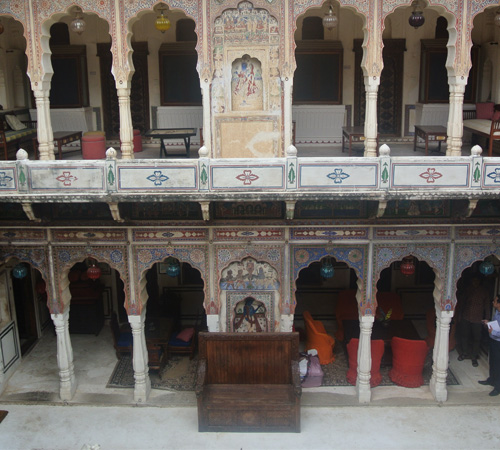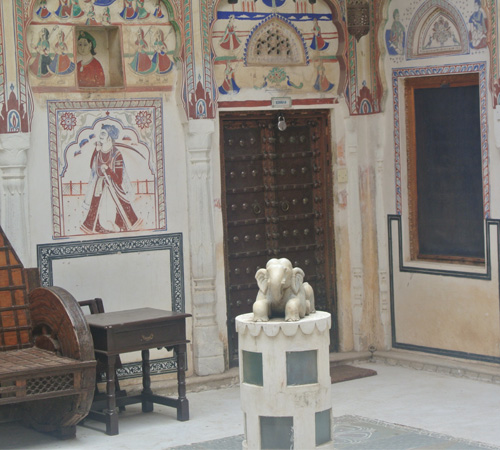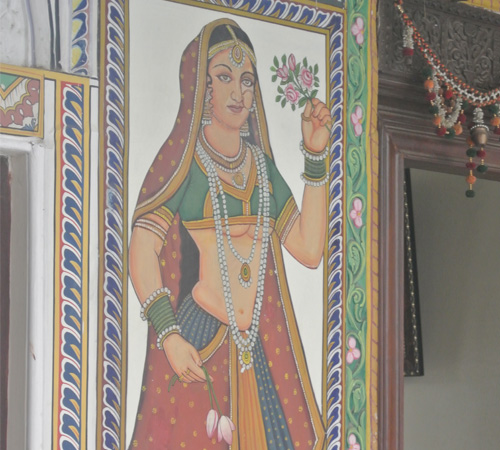
Visit the open air art gallery of Rajasthan
Welcome to Shekhawati,where many of the houses in more than 20 villages have paintings on their walls. The famous villages are : Magical Mandawa village and Dramatic Dundlod village and Marvellous Mukandgarh and none such as Nawalgarh village and Fabulous Fatehpur (Nestling in the heart of Shekhawati, Fetehpur or the Town of Victory is a good place to be based in when you are investigating Rajasthan’s open-air art gallery) and Magnificent Mahansar and Ramgarh village and lovely Lakshmangarh.
The once-forgotten havelis of Shekhawati, with their extraordinary paintings are now firmly on the tourist trail luring visitors with the promise of seeing something unique. What visitors find are stately crumbling structures, ornamented with exuberant paintings. These were built to showcase the status of their masters, and painted to reinforce it. Some paintings celebrated the glorious past, others celebrated the new industrial age, giving the now mundane train and motorcar pride of place. The painted towns are fast disappearing, although conservation efforts have begun. These aim at saving the havelis and paintings, some of which have already been obliterated with coats of whitewash or lampblack where cooking stoves have been lit right under the paintings.
The name Rajasthan immediately brings to mind images of a stark landscape and a proud people, fiercely independent and forever at war. Shekhawati’s history is no different. Around the 14th century, the towns in this region became important trading posts on the caravan routes that wound their way to neighbouring Gujarat.
The havelis are mostly built of local materials, and other than the front facade, the exterior walls are unexceptional. The main entrance usually featured a pair of massive doors, for the protection of the inhabitants, and sometimes incorporating quarters for the watchman and guards. Above this main entrance were torans or flags that represented the marriage of a girl from the family. Most have a parrot design worked on them, who is considered to be the messenger of love. Many feature two courtyards, one for the men and the other, enclosed one for the women, who were kept in purdah. The baithak, literally the sitting room was where the men of the household would do business and entertain their friends. Some houses incorporate two baithaks, for the extended family. This would generally be the finest room in the haveli. Above the baithak, there would be enclosed rooms accessible from the women’s quarters, for them to sit in on discussions without being seen. The courtyard of the haveli was the major focus of life for the family. It was where the housework was done, and where the women spent most of their time. For this reason, the courtyard could be accessed only by family members, relatives and friends. A staircase from the courtyard leads up to the second floor rooms, which were mostly used as bedrooms. The stairs would continue on to the roof. The family would also use the roof as an open-air bedroom in the summer to get some relief from the fierce heat. Some of the havelis have up to four floors. The earliest paintings show Mughal influences incorporating floral and geometric designs. But later on, themes from mythology, religion and folk tales began to predominate. Over a period of time, a synthesis of the eastern and western worlds also began to manifest itself for example pictures of trains, English monarchs, views of Venice, leaders of the Indian freedom struggle, elephants, phirang (foreign) soldiers, cars and many more subjects.
The painters used mostly powdered colours, usually red., green and yellow ochres; lampblack and lime were also used. There were two methods, a succor technique, where the painting was executed after the plaster had dried, and a fresco technique where the pigment was applied onto wet plaster. Havelis were also re-painted when they began to look shabby or just before occasions like a marriage in the family. Not much is known about the painters. It is theorized that the havelis were mostly painted by itinerant craftsmen from Jaipur and then later by local men, mostly masons, who rose to meet the demand.



